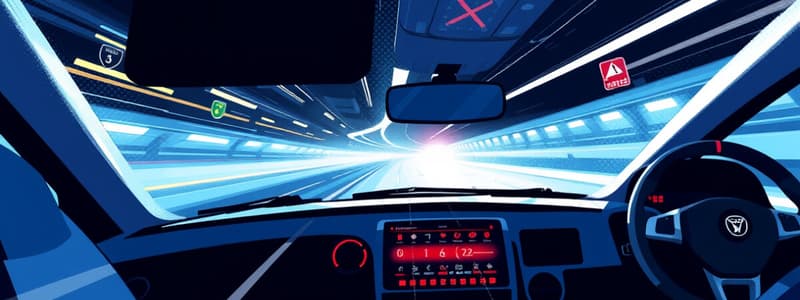Podcast
Questions and Answers
What does the IPDE Process stand for?
What does the IPDE Process stand for?
- Inspect, Proceed, Drive, Examine
- Identify, Predict, Decide, Execute (correct)
- Initiate, Plan, Drive, Execute
- Identify, Plan, Decide, Execute
The Zone Control System helps you manage 6 zones of space around your vehicle.
The Zone Control System helps you manage 6 zones of space around your vehicle.
True (A)
What are some basic tools for low-risk driving?
What are some basic tools for low-risk driving?
Good searching habits and the ability to manage space on the roadway.
What contributes to risk factors while driving?
What contributes to risk factors while driving?
What is the definition of 'safe driving'?
What is the definition of 'safe driving'?
What is the consequence of not giving your undivided attention to driving?
What is the consequence of not giving your undivided attention to driving?
The first step of the IPDE Process is _______.
The first step of the IPDE Process is _______.
The second step of the IPDE Process is _______.
The second step of the IPDE Process is _______.
The third step of the IPDE Process is _______.
The third step of the IPDE Process is _______.
The fourth step of the IPDE Process is _______.
The fourth step of the IPDE Process is _______.
What should you check when there is a change from multilane to single lane?
What should you check when there is a change from multilane to single lane?
Which of the following is a type of searching range?
Which of the following is a type of searching range?
What should you predict about other drivers at an intersection?
What should you predict about other drivers at an intersection?
What is the most important factor in maintaining control of your vehicle?
What is the most important factor in maintaining control of your vehicle?
What is traction?
What is traction?
What is one basic part of driving knowledge?
What is one basic part of driving knowledge?
How can experience improve your driving skills?
How can experience improve your driving skills?
What actions can you take to avoid a predicted point of conflict?
What actions can you take to avoid a predicted point of conflict?
What does it mean to change lane position?
What does it mean to change lane position?
What is a space cushion?
What is a space cushion?
Match the lane positions to their descriptions:
Match the lane positions to their descriptions:
When should you communicate with other users of the roadway?
When should you communicate with other users of the roadway?
What is the safest position in traffic?
What is the safest position in traffic?
What does it mean to minimize a hazard?
What does it mean to minimize a hazard?
What is the purpose of combining actions while driving?
What is the purpose of combining actions while driving?
Flashcards
IPDE Process
IPDE Process
A systematic method for managing driving risks by identifying hazards, predicting outcomes, deciding on actions, and executing them.
Risk Factors
Risk Factors
Elements that increase the likelihood of a driving collision, including the driver, vehicle, roadway, and environment.
Driver-contributed risks
Driver-contributed risks
Driving hazards caused by the driver, such as distractions, recklessness or poor judgment.
Vehicle-Contributed Risks
Vehicle-Contributed Risks
Signup and view all the flashcards
Roadway and Environment contributed risks
Roadway and Environment contributed risks
Signup and view all the flashcards
Zone Control
Zone Control
Signup and view all the flashcards
Visual Search
Visual Search
Signup and view all the flashcards
Central Vision
Central Vision
Signup and view all the flashcards
Peripheral Vision
Peripheral Vision
Signup and view all the flashcards
Depth Perception
Depth Perception
Signup and view all the flashcards
Scanning Technique
Scanning Technique
Signup and view all the flashcards
Predictive Strategies
Predictive Strategies
Signup and view all the flashcards
Space Cushion
Space Cushion
Signup and view all the flashcards
Lane Position
Lane Position
Signup and view all the flashcards
Communication with Users
Communication with Users
Signup and view all the flashcards
Hazard Management
Hazard Management
Signup and view all the flashcards
Traction
Traction
Signup and view all the flashcards
Vehicle Control
Vehicle Control
Signup and view all the flashcards
Changing Speed
Changing Speed
Signup and view all the flashcards
Changing Direction
Changing Direction
Signup and view all the flashcards
Knowledge Acquisition
Knowledge Acquisition
Signup and view all the flashcards
Predictive Skill
Predictive Skill
Signup and view all the flashcards
Driving Experience
Driving Experience
Signup and view all the flashcards
Study Notes
IPDE Process and Zone Control
- Organized system for risk management and safe driving enhances a driver's ability to manage situations effectively.
- Tools for low-risk driving: good searching habits and space management help in achieving low-stress driving.
Risk Factors
- Collision risks stem from four main contributors: driver, vehicle, roadway, and environment.
- Awareness of all contributing factors is essential to assess and manage driving risks.
Driver-Contributed Factors
- Distractions such as adjusting the radio or using a phone increase driving risks.
- Other drivers’ recklessness can also heighten hazards on the road.
Vehicle-Contributed Factors
- Proper vehicle maintenance, such as checking tires and lights, is crucial for safe driving.
- Unmaintained vehicles can significantly raise the chances of accidents.
Roadway- and Environment-Contributed Factors
- Weather conditions including sun glare, rain, and road conditions like construction or ice present driving challenges.
- Constant vigilance regarding environmental conditions is necessary to maintain safety.
Safe Driving Principles
- Correctly analyzing traffic situations increases safety, but thorough attention is required to identify all crucial clues.
- Employing systematic methods for assessing traffic possibilities leads to fewer close calls and accidents.
Steps of the IPDE Process
- Identify: Use a visual search pattern to detect hazards in the driving environment.
- Predict: Based on identified hazards, foresee their impact on your intended travel path.
- Decide: Choose actions to either maintain speed, change direction, or communicate with others based on predictions.
- Execute: Carry out decided actions using vehicle controls and safety features to manage potential conflicts.
Zone Control System
- Management involves overseeing six zones of space around a vehicle for safety.
- Processing changes in zones involves three steps: recognize zone changes, check other zones, and adjust vehicle control and positioning accordingly.
Searching Ranges
- Target-area range: Focus on the distance to the target area, assessing conditions that may affect your path.
- 12-15 second range: Evaluate the area you will travel to in the next 12-15 seconds for changes and closed zones.
- 4-6 second range: Provides final updates on conditions right before reaching that space.
Visual Search Patterns
- Develop an orderly visual search pattern to regularly check critical areas.
- Routine evaluations help sustain attention and increase awareness of the driving environment.
Aspects of Vision
- Effective driving requires three primary aspects: central vision for detailed focus, peripheral vision for broader awareness, and depth perception for judging distances.
Scanning Techniques
- Continuous scanning enhances alertness and prevents risky driving habits caused by staring.
- Selective seeing helps focus on important driving clues while ignoring non-critical distractions.
Interactions with Other Users
- Monitor movements of other drivers, pedestrians, and cyclists to prevent conflicts.
- Understanding behaviors of drivers can aid in predicting potential hazards on the road.
Roadway Features and Conditions
- Early identification of intersections, hills, and changes in lane width are crucial for maintaining control.
- Awareness of ongoing roadway conditions, such as construction or weather impact, is essential.
Predictive Strategies
- Predictions should focus on actions of other drivers, personal vehicle control, and potential consequences of actions.
- Effective predictions can prevent conflicts and increase overall safety when driving.
Traction and Vehicle Control
- Traction is critical for maintaining control; it refers to the grip between tires and the roadway.
- Adjust driving methods based on road conditions to ensure effective vehicle control.
Knowledge Acquisition
- Understanding traffic laws and safe driving practices is fundamental to becoming a responsible driver.### Driving Knowledge and Experience
- Accumulating driving experience adds to a "safe-driving memory bank" that enhances knowledge.
- More driving experience leads to improved ability to identify and predict potential hazards, fostering low-risk driving.
Judgment in Driving
- Making judgments involves assessing speed, space, distance, traction, and visibility on the road.
- Evaluating personal and other drivers' performances helps develop sound decision-making and accurate predictions.
Experience and Prediction
- Driving experience contributes to better predictive skills, enabling safer decisions.
- Exposure to various driving situations enhances the ability to evaluate potential outcomes before taking action.
Changing Speed
- Speed decisions are influenced by the velocity of one's vehicle and others.
- Maintaining speed, decelerating, braking, and accelerating are all valid responses depending on the situation.
Changing Direction
- Direction changes require steering adjustments, potentially including multiple lane changes.
- Awareness of changing conditions ahead (at least 15 seconds in advance) aids in timely decision-making.
Space Cushion
- Maintaining a space cushion allows for escape paths to mitigate potential conflicts.
- The area surrounding the vehicle should be monitored to ensure adequate space is maintained.
Lane Positions
- Lane Position 1: Ideal position under normal conditions; vehicle centered.
- Lane Position 2: Used when right-front zone is closed; slight left adjustment required.
- Lane Position 3: Utilized when left-front zone is closed; slight right adjustment needed.
Communication with Other Road Users
- Effective communication includes using lights, horn, gestures, and body movements to signal intentions.
- Clear communication helps reduce the risk of unexpected changes in speed or direction.
Managing Traffic Flow
- Aim for a driving position with minimal surrounding vehicles to maintain safety.
- Continuously assess surrounding zones; adjust speed and direction to prevent conflicts.
Hazard Management
- Minimize Hazards: Increase distance from hazards to lower conflict potential.
- Separate Hazards: Adjust speed to manage multiple hazards sequentially rather than simultaneously.
- Compromise Space: When separation isn’t possible, give the most space to the most dangerous hazard.
Essential Driving Actions
- Key driving actions include controlling speed, steering, and communicating with other roadway users.
Control Speed
- Speed management may involve deceleration or maintaining speed influenced by traffic signals or conditions.
- Utilize firm braking in emergencies, avoiding wheel lock for controllable steering.
Steering Techniques
- Execute the necessary amount of steering to avoid conflicts without excessive or minimal movements.
- Maintaining a space cushion increases chances of finding escape paths.
Communicative Signals
- Use headlights, taillights, turn signals, and vehicle positioning to signal other drivers.
- Headlights: Activate in low visibility; automatic headlights enhance daytime visibility.
- Turn Signals: Engage 3-5 seconds before direction changes, ensuring others are informed.
Other Communication Tools
- Horn: Use a light tap for warnings; louder blasts reserved for emergencies.
- Vehicle Position: Clearly indicates the intended path and intentions.
- Eye Contact and Body Movement: Engaging other drivers through eye contact or gestures can clarify intentions.
Combining Actions
- Often necessary to employ multiple actions such as steering while accelerating.
- Utilizing the IPDE (Identify, Predict, Decide, Execute) model aids in executing safe maneuvers.
Overall Safety Management
- Drivers must manage space, time, and speed to enhance safety in the Highway Transportation System (HTS).
Studying That Suits You
Use AI to generate personalized quizzes and flashcards to suit your learning preferences.




